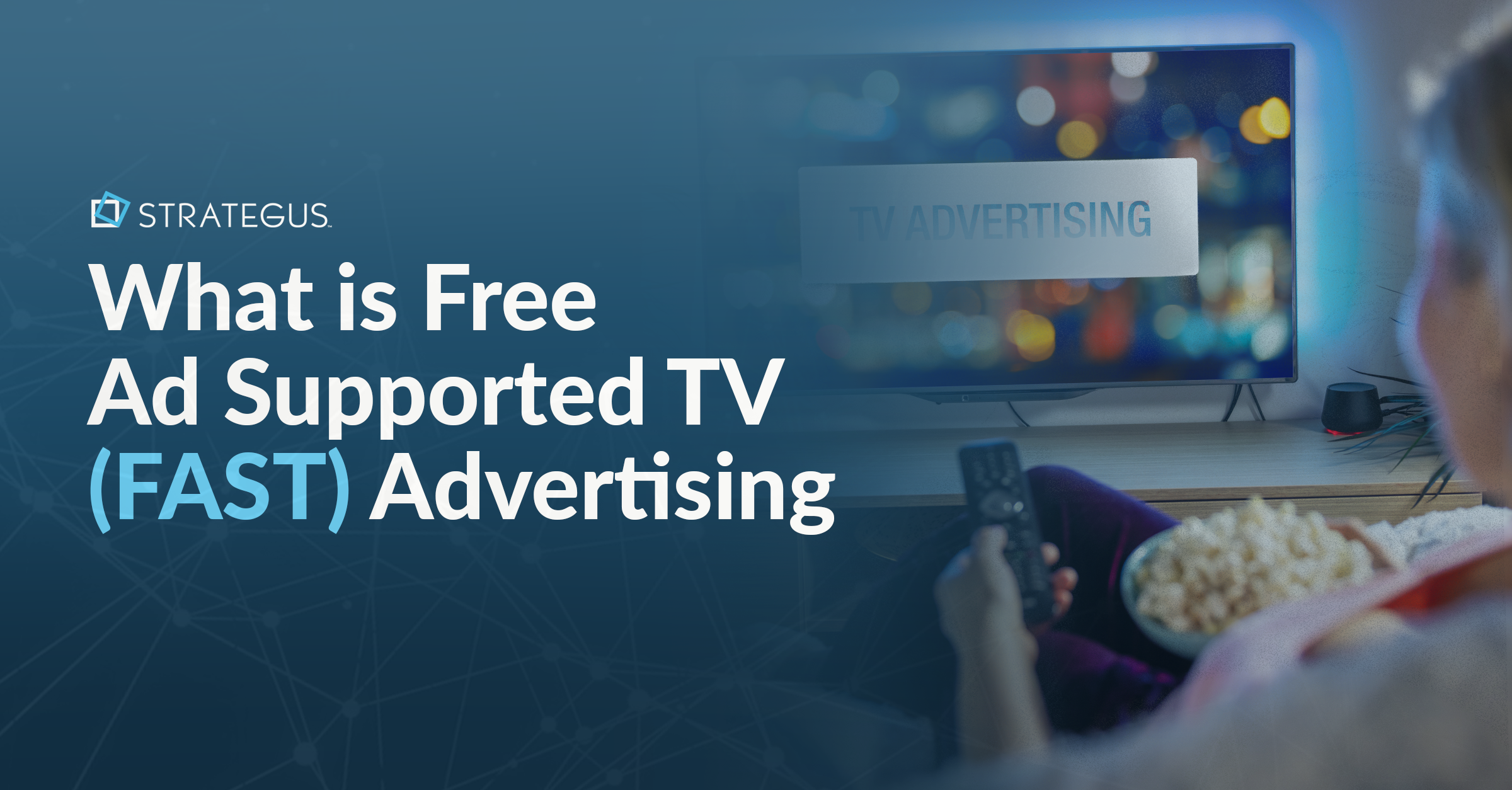- Home
- Strategus Blog
- What is Free Ad Supported TV (FAST) Advertising? 2025 Guide
What is Free Ad Supported TV (FAST) Advertising? 2025 Guide
 Traci Ruether
Traci Ruether
18 minutes read

Free streaming with ads wasn't supposed to work. Netflix built an empire on the promise of commercial-free viewing. Consumers happily paid premiums to escape advertising. And then the TV industry changed and it changed fast.
Subscription fatigue hit hard. The average household now juggles seven streaming services, spending more than they ever did on cable. Meanwhile, Tubi quietly amassed 80 million monthly users by offering something radical: free content with commercial breaks. Pluto TV, Roku Channel, and others followed suit, creating what we now call FAST: Free Ad-Supported Television.
For advertisers, FAST solved a massive problem. Traditional TV audiences were vanishing, but premium streaming inventory remained frustratingly limited and expensive. FAST channels offered the reach of linear TV with the targeting capabilities of digital advertising.
This guide explains what FAST advertising actually delivers. You'll learn which platforms drive real results, how FAST fits into your broader CTV strategy, and why some brands are seeing better ROI here than on traditional streaming services.
Key Takeaways
- FAST delivers linear, curated channels over streaming, funded by ads, offering cable-like viewing without subscriptions.
- Audience reach rivals linear TV while digital targeting and measurement enable precise, outcome-driven campaigns.
- Programmatic buying with SSAI inserts ads in milliseconds, supporting frequency control, dayparting, and brand-safe placements.
- Key distinctions separate FAST from AVOD and cable, including schedule-based streams, OTT delivery, and richer attribution.
- Rising usage stems from subscription fatigue and lean-back simplicity, yielding cost-efficient CPMs and incremental reach.
- Strategus provides fully managed FAST campaigns with advanced attribution, cross-device retargeting, and real-time optimization for measurable ROI. Speak to a Strategus expert to learn more today.
What Is FAST Streaming?
Also called free ad-supported TV, FAST is a category of streaming services that deliver a predetermined lineup of video content without requiring a paid subscription.
This broadcast model generates revenue entirely from commercials and looks a lot like the programming we used to consume in the pre-Netflix era. Popular FAST services include Pluto TV, Tubi, and the Roku Channel with more popping up every day.
In many ways, FAST is the streaming world’s answer to our nostalgia for cable TV. After all, sometimes even cord-cutters want to power up the TV and let a scheduled broadcast play without giving it any thought.
This type of lean-back viewing isn’t just about cutting down on your subscription spend. It offers a welcoming break from on-demand services. The average American now spends 45 hours a year figuring out what they'll watch next when using platforms like Hulu and Amazon Prime.
With FAST, the only choice viewers have to make is which channel to land on.
Factors Driving FAST Adoption
Beyond costs, many viewers are tuning into FAST due to its format. Here’s a look at the factors that are pushing users towards this form of TV.
- Analysis Paralysis: At the end of a long day, turning on a linear channel is often more appealing than sorting through countless titles.
- Cost Efficiencies: Ad-supported streaming is on the rise across the board, giving users a way to minimize entertainment expenses.
- Ease of Use: From eliminating the need for a password to delivering a simpler UI, the most popular FAST apps remove the clutter that prevents users from hitting play.
- Subscription Fatigue: With so many platforms vying for our attention, viewers are sick of having to pay for ten different services. FAST services do away with the costs and required sign-in, meaning viewers don’t even need to enter a password.
- Personalization: Most FAST channels are curated, with entire teams dedicated to creating content lineups that keep viewers engaged.
What Makes FAST Different?
FAST streaming is such a new concept that it’s worth spelling out how it's different from the broadcast models we know well.
While many are quick to conflate it with advertising-based video on demand (AVOD), there are distinctions between the two. The same is true for how it compares to linear TV. Here’s a closer look at these related concepts.
1. FAST vs. Linear TV
If you’ve ever watched Saturday morning cartoons, then you’re familiar with linear TV.
Linear TV refers to the traditional method of television broadcasting, where content is delivered to viewers in a scheduled, predetermined sequence. With linear TV, programs are broadcast over a specific set of channels at predetermined times, and viewers tune in to watch them as they air.
With the heightened demand for digital streaming services and on-demand viewing options, many assume that this model will become obsolete. That’s because true linear TV is delivered via cable and satellite, both of which are losing market share to streaming services.
FAST, on the other hand, is delivered using streaming technology. It can be considered the next generation of linear TV, optimized for modern OTT distribution and designed specifically for viewing on CTV devices.
Another major difference between FAST and linear TV is how the commercials are served. Traditional TV advertising is more costly and less targeted than FAST advertising because the audience pool is broader. It’s also challenging to measure the results of traditional TV campaigns, which limits the ability to optimize marketing efforts based on data.
TL;DR: Linear TV is distributed over the air using traditional broadcast technologies like cable; FAST is distributed over the top using online streaming.
2. FAST vs. AVOD
AVOD is a giant category comprising everything from social media sites like YouTube to streaming services like Hulu. Any app that lets you play videos on demand in exchange for watching advertisements falls within the AVOD umbrella.
And even Hulu is a questionable example of AVOD. Rather, the platform would be more accurately labeled as hybrid video on demand (HVOD) because it generates revenue from both advertisements and monthly subscription fees.
With AVOD, content is served to viewers on a one-to-one basis after being initiated by the viewer. The “on demand” part of AVOD is what differentiates it from FAST.
That’s because with FAST streaming TV, users get access to 24/7 broadcasts. These linear channels are delivered on a one-to-many basis, meaning the primary content is delivered to mass audiences at the same time.
Both AVOD and FAST provide the ability to serve personalized ad experiences based on precise demographics. Granular data about the viewers’ online behaviors, real-time location, and more enable advertisers to market to their exact audience and track their behaviors after the fact.
TL;DR: FAST and AVOD are both ad-supported streaming models, but AVOD describes click-to-play video content, whereas FAST channels are constrained by a broadcasting schedule.
How Does FAST Advertising Work?
Things are a bit more technical behind the scenes. Because streaming opens up opportunities to deliver more targeted ads, FAST advertising uses programmatic media placement.
These commercials are purchased via programmatic auctions, the same way most CTV advertising campaigns are executed today. This involves the participation of the supply-side platforms (SSPs) that sell ad inventory on behalf of publishers, the demand-side platforms (DSPs) that enable advertisers to bid on and purchase ad impressions across various ad exchanges, and the data providers that make targeting precise.
Here's how the entire process unfolds in real-time, from the moment a viewer selects content to when an ad appears on their screen:
- The Viewer Trigger: When someone clicks play on a FAST channel or selects on-demand content, the platform identifies an upcoming ad break and sends a bid request containing anonymous viewer data: device type, location, viewing history, and demographic indicators.
- The Auction Begins: The SSP receives this request and broadcasts it to multiple DSPs within milliseconds. Each DSP evaluates whether this viewer matches their clients' target audiences using first-party and third-party data signals.
- Bidding War: Interested advertisers submit bids through their DSPs based on campaign parameters like budget, targeting criteria, and frequency caps. The highest bidder wins the impression, typically within 100 milliseconds.
- Ad Delivery: The winning ad is instantly delivered to the viewer's device through server-side ad insertion (SSAI) or client-side ad insertion (CSAI), ensuring smooth playback without buffering.
- Performance Tracking: Post-delivery, the platform tracks completion rates, engagement metrics, and attribution data, feeding this information back to advertisers for campaign optimization.
Best Practices for FAST Advertising
To succeed on FAST, it’s all about delivering relevant experiences backed by data. A lot of the core principles of TV marketing apply to FAST as well. Regardless, here are some things you should be keeping in mind.
- Personalization and Targeting: Make sure the right eyes are landing on your ads by pinpointing your audience based on hobbies, shopping habits, and more.
- Frequency: Optimize your campaign frequency by limiting the number of times your ad is shown to the same person. This is critical to prevent ad fatigue (which occurs when viewers are bombarded by the same commercial on repeat).
- Full-Funnel Tactics: Move buyers from awareness to conversion by retargeting FAST viewers across supplementary digital channels like display or streaming audio.
- Multi-Touch Attribution: Quantify ROI at every touchpoint and continuously optimize your campaigns by finding an advertising partner that offers granular insight into the impact of your ads by illustrating how your viewer progresses through the conversion funnel.
Top FAST Channels & Services to Advertise On
Free ad-supported streaming services available right now fall into three categories: independent services like Crackle, those owned by device manufacturers like Roku, and FAST tiers offered by major media corporations like Comcast.
Here’s a side-by-side comparison of the most popular services.
1. Pluto TV (Paramount)

As one of the earliest movers in the FAST space, Pluto TV launched in 2014 as an April Fool's Joke. The joke, it turns out, was a lucrative one and is now generating more than $1 billion in ad revenue last year.
Paramount acquired Pluto TV in 2019, and the platform now offers 250+ channels for users to flip between.
Plenty of Paramount content can be found on the platform, as well as Spanish-language programming, local TV, and an array of niche channels like gaming and anime. Pluto TV is also available on a vast range of devices, including Apple, Google, LG, and Samsung TVs; Amazon Fire and Roku devices; and the web.
2. Tubi (Fox)

According to Nielsen, Tubi has surpassed Pluto TV in viewership, now accounting for 1% of all streaming. The Fox-owned service has a large collection of free content sourced from Warner Bros Discovery, Lionsgate, MGM, and more. While Tubi’s channel content lags slightly behind Pluto TV, many users prefer the UI.
3. The Roku Channel

The Roku Channel has extensive content across its 350+ channels and premium original content that is exclusive to the platform.
Many Roku TV and device users tune in because the app is front and center when they power up their devices. But access to the Roku Channel is fairly limited for non-Roku users. It’s only available on the living room TV if you have a Roku device, Amazon Fire device, or Samsung smart TV.
4. Xumo Play (Comcast)

Xumo is part of Comcast and Charter Communications streaming hardware play, whereby the cable broadcaster is attempting to go head-to-head with brands like Roku that offer both streaming devices and services.
The Xumo platform lives inside of Comcast’s hardware (specifically, the company’s Xumo TVs and Xumo set-top boxes) and can also be accessed using Roku and Amazon streaming devices.
Other popular free streaming services for smart TVs include:
- Amazon Freevee
- Crackle
- Sling Freestream
- Vudu
- Plex
- Samsung TV Plus
- Local Now
Closing Thoughts — Doing FAST Advertising the Right Way
FAST advertising represents an exciting evolution in TV, but it also introduces new complexities for advertisers. From understanding audience behavior on these channels to optimizing ad placements across streaming platforms and CTV devices, executing campaigns effectively requires specialized knowledge and hands-on management.
That’s where Strategus comes in. As a fully managed advertising partner, we take the burden off your team by handling every aspect of FAST campaigns, from strategic planning and audience targeting to creative execution and performance optimization. Our hands-on approach ensures your ad dollars are spent efficiently while maximizing reach and engagement, giving you the confidence that campaigns are running smoothly and delivering measurable results.
If you want to advertise on FAST without the guesswork, we can help. Speak to a Strategus expert today to learn more.
Frequently Asked Questions
1. How Much Does It Cost to Advertise on Pluto TV?
Advertising on Pluto TV typically starts around $10 to $30 CPM (cost per thousand impressions), depending on targeting, time slots, and ad inventory. Larger budgets get access to broader placements and better frequency. For exact pricing, advertisers usually go through programmatic platforms or managed service providers.
2. How to Advertise on TV Channels Like Tubi or Roku Channel?
To advertise on Tubi or The Roku Channel, use a demand-side platform (DSP) or partner with a managed service provider. You’ll need to define your target audience, set your budget, and upload creative assets. The platform will then place your ads across relevant channels within the FAST ecosystem.
3. What Types of TV Advertising Packages Are Available for FAST Platforms?
FAST platforms offer various ad packages, including pre-roll, mid-roll, banner overlays, and sponsorships of specific channels. Advertisers can choose between audience-targeted buys, geo-targeting, and fixed CPM campaigns. Some platforms also allow dayparting and content-specific targeting for more precise delivery.
4. How Do Free Streaming Sites Like Pluto TV and Tubi Make Money?
Pluto TV and Tubi earn revenue by selling ad space to brands. They serve these ads during commercial breaks across their content lineup. Since users don’t pay subscription fees, advertising remains their primary source of income. Their programmatic setup allows scalable monetization across many viewer segments.
5. Does Pluto TV or Tubi Have More Ads?
Tubi generally has fewer ads than Pluto TV, but the difference varies by content type and viewing time. Both platforms average 4 to 8 minutes of ads per hour. Advertisers should consider engagement rates and viewer drop-off when comparing ad volume across these FAST platforms.
6. Can You Get Pluto TV Without Ads?
No, Pluto TV does not offer an ad-free version. The platform runs entirely on an ad-supported model, which allows users to access content for free. Since there are no subscription fees, viewers must watch regular commercial breaks during programs.
7. What Kind of Ads Does Fast TV Support (e.g., Skippable, Interactive, 15s/30s)?
FAST platforms typically support non-skippable ads, including 15-second and 30-second spots. Some services also allow interactive ad formats, such as clickable overlays or QR codes. Advertisers can choose formats based on campaign goals, creative assets, and available inventory on the platform.

Traci Ruether is a content marketing consultant specializing in video tech. With over a decade of experience leading content strategy, she takes a metrics-driven approach to storytelling that drives traffic to her clients' websites. Follow her on LinkedIn at linkedin.com/in/traci-ruether or learn more at traciruether.com.
Strategus is a managed services connected TV(CTV) advertising agency with over 60,000+ campaigns delivered. Find out how our experts can extend your team and drive the result that matter most.
Talk to an Expert
Table of Contents
- What Is FAST Streaming?
- What Is Not FAST Streaming?
- How Does Free Ad-Supported TV Work?
- How Does FAST Advertising Work?
- The Trend Towards Free Streaming TV Channels
- Streaming Devices Give Way to FAST Channels
- FAST Advertising Growth and What It Means for Marketers
- Best Practices for FAST Advertising
- Top FAST Channels and Services to Advertise On
- Get Started With Strategus
Seeking a Custom CTV Strategy That Delivers?
What to read next

How Auto Dealers Can Build a Winning First-Party Data Strategy
Your Dealership’s Data is More Powerful Than You Think
4 minutes read
App Event Tracking: Tie Mobile App Activity to CTV Campaigns
Let’s say you’re running a CTV campaign for a personal finance app.
5 minutes read

Stop Guessing Who Your Audience Is — Let Their Apps Tell You
Connected TV (CTV) targeting often falls in one of two camps.
8 minutes read
See Who Bought After Your Ad + How Much They Spent
You can’t improve what you can’t measure. And for years, that’s been a major problem with TV advertising.
4 minutes read
















